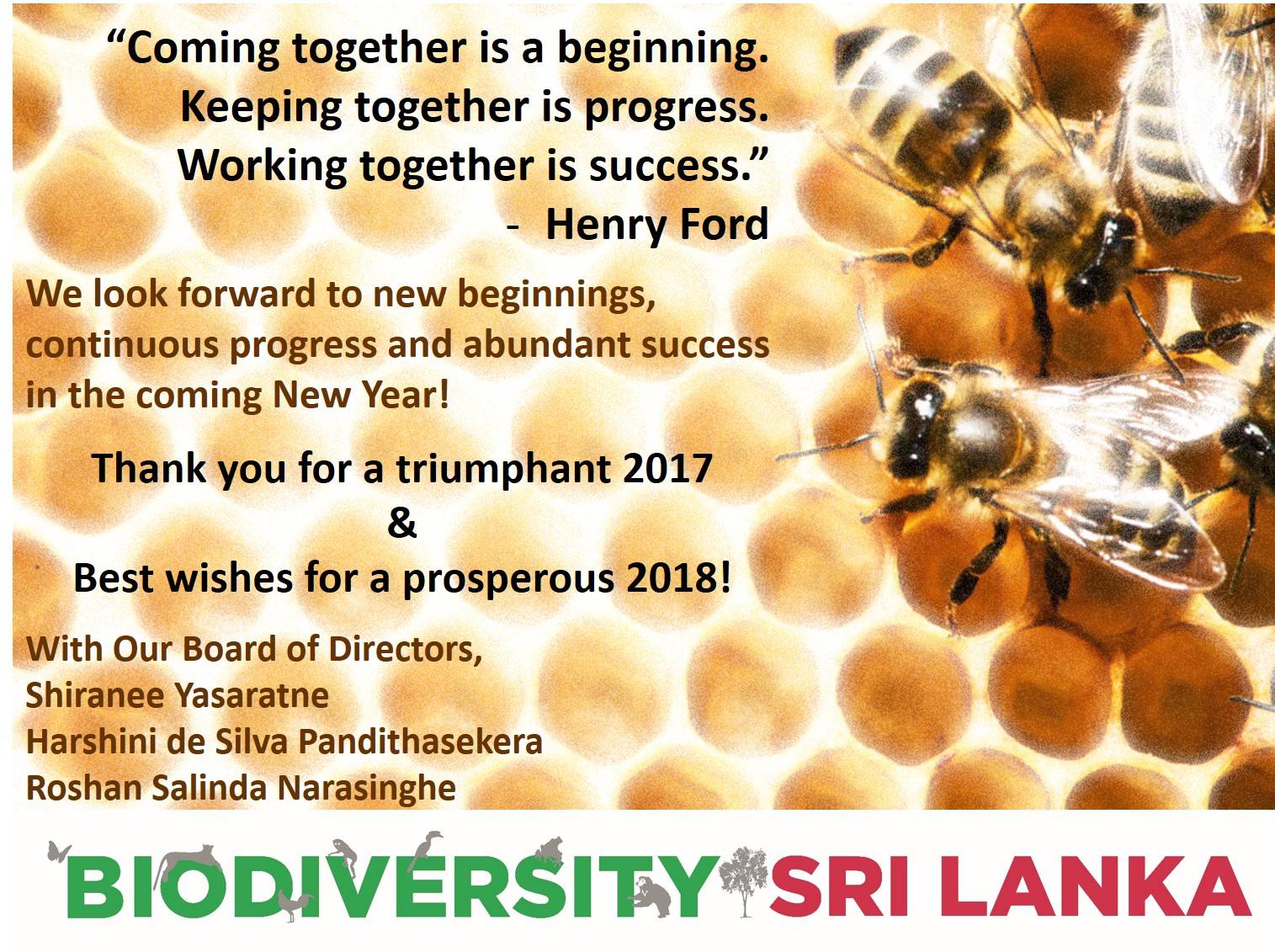
Revitalising Our Parks for Wildlife Restoration
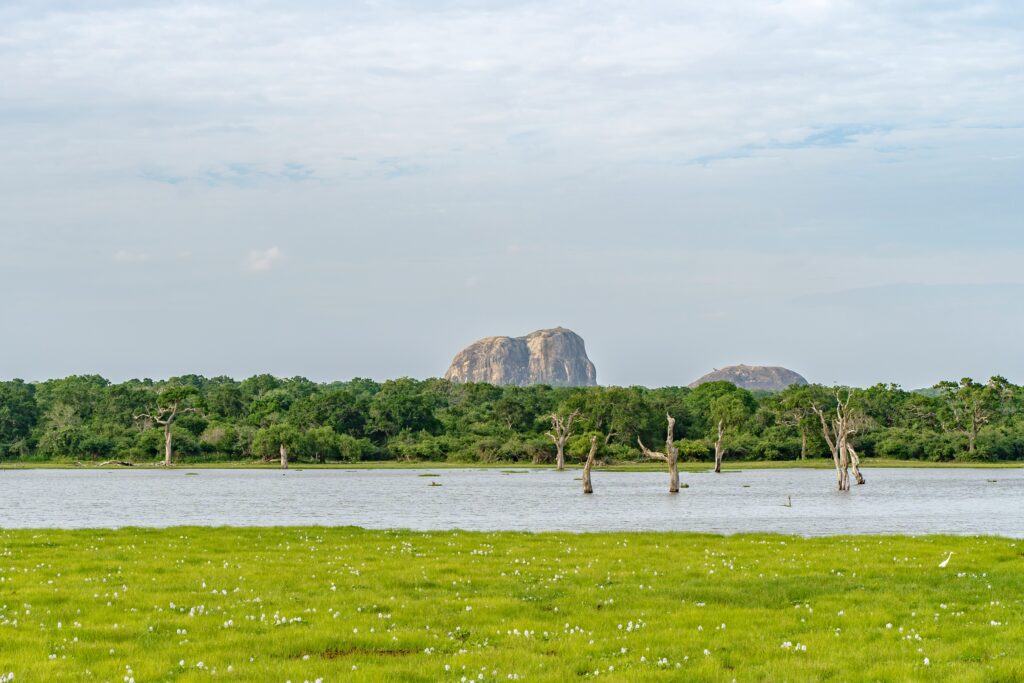
The “LIFE to Our National Parks” (LONP) project is making significant strides in restoring the biodiversity of Sri Lanka’s Lunugamvehera National Park, a crucial sanctuary for wildlife and a key migratory route for elephants. This ambitious initiative focuses on reversing the damaging effects of Invasive Alien Plant Species (IAPS), which have overrun large portions of the park, drastically affecting the habitat and feeding grounds for herbivores. Two of the most problematic species targeted by this project are Lantana camara (commonly known as Gandapana) and Eupatorium odoratum (Podi Singho Maran), both notorious for their aggressive spread and ability to choke out native vegetation, threatening the park’s delicate ecological balance.
The project is spearheaded by the Federation of Environmental Organizations (FEO) in collaboration with the Department of Wildlife Conservation (DWC), under the broader umbrella of Biodiversity Sri Lanka’s mission to enhance the vitality of the nation’s protected areas. These restoration efforts began in 2021, with manual removal methods aimed at eliminating Lantana camara and Eupatorium odoratum from large areas of the park, allowing native flora to regenerate. Early results have been encouraging, with native grasses returning and wildlife like elephants and deer rediscovering their natural feeding grounds.
Entry of the Champions
A major success for the LONP project has been the involvement of private sector partners. HNB Assurance (HNBA) was the first corporate entity to join the project in November 2023, funding the clearing of 15 hectares of invasive plants. By January 2024, the initial phase was complete, and HNBA committed to supporting the restoration of an additional 15 hectares, bringing their total contribution to 30 hectares of habitat revitalization. Their involvement has been a critical component in restoring essential feeding grounds for elephants and other herbivores, which is also helping to reduce human-wildlife conflict in nearby communities.
Following HNBA’s lead, DIMO Lanka recently joined the LONP project as a new partner, further strengthening the initiative by committing to restore another 15 hectares of land. With the inclusion of DIMO Lanka’s contribution, the total area under restoration now stands at 45 hectares, showcasing the expanding influence of the LONP project. This collaborative approach, involving both public and private sector stakeholders, reflects a growing recognition of the need for concerted efforts to address environmental degradation in Sri Lanka’s national parks.
Multiple Impacts
The project’s impact extends beyond environmental restoration. Local communities, many of whom were adversely affected by the economic fallout from the COVID-19 pandemic, have benefited from employment opportunities created by the project. Around 60 workers from nearby villages have been involved in the labor-intensive process of manually removing the invasive plants, providing them with a stable source of income. This not only uplifts the livelihoods of these communities but also fosters a sense of environmental stewardship among local residents.
The removal of IAPS is also crucial in addressing the ongoing human-elephant conflict in the region. As invasive species have taken over key habitats, elephants have been forced to move beyond park boundaries in search of food, often resulting in damage to crops and conflict with local farmers. By restoring the park’s natural feeding grounds, the LONP project aims to reduce these conflicts and create a more harmonious relationship between humans and wildlife.
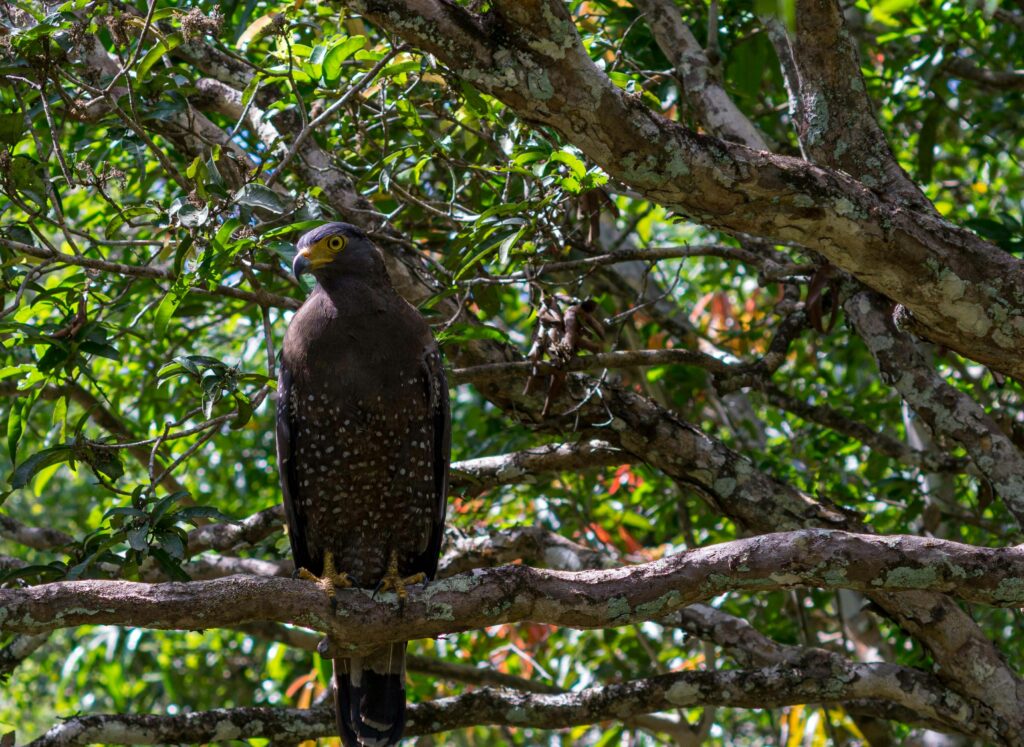
A Transformative Initiative
As we celebrate the achievements of the “LIFE to Our National Parks” project, we recognise that meaningful change is only possible through collaboration. We invite more private sector companies to join this transformative initiative and contribute to the restoration of Sri Lanka’s precious ecosystems. Your partnership can amplify our efforts to revitalise Lunugamvehera National Park, enhance biodiversity, and support local communities affected by environmental challenges. Together, we can create a sustainable future where wildlife thrives, and local livelihoods prosper. Join us in making a lasting impact – your involvement is key to nurturing the natural heritage of Sri Lanka!
10 Best National Parks of Sri Lanka:
https://www.youtube.com/watch?v=9U-4lenJ9Do
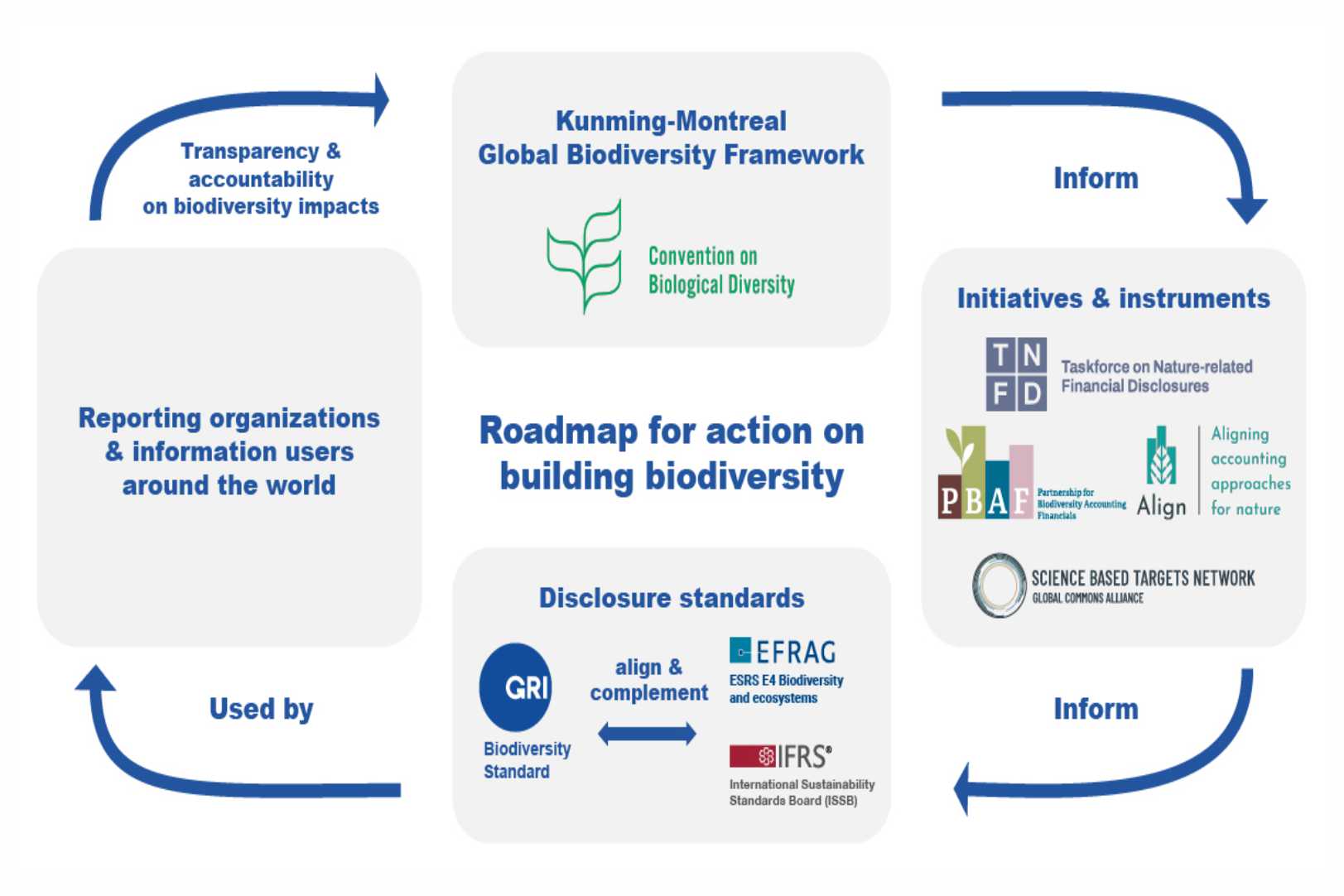
The Business Case for Enhanced Biodiversity Reporting
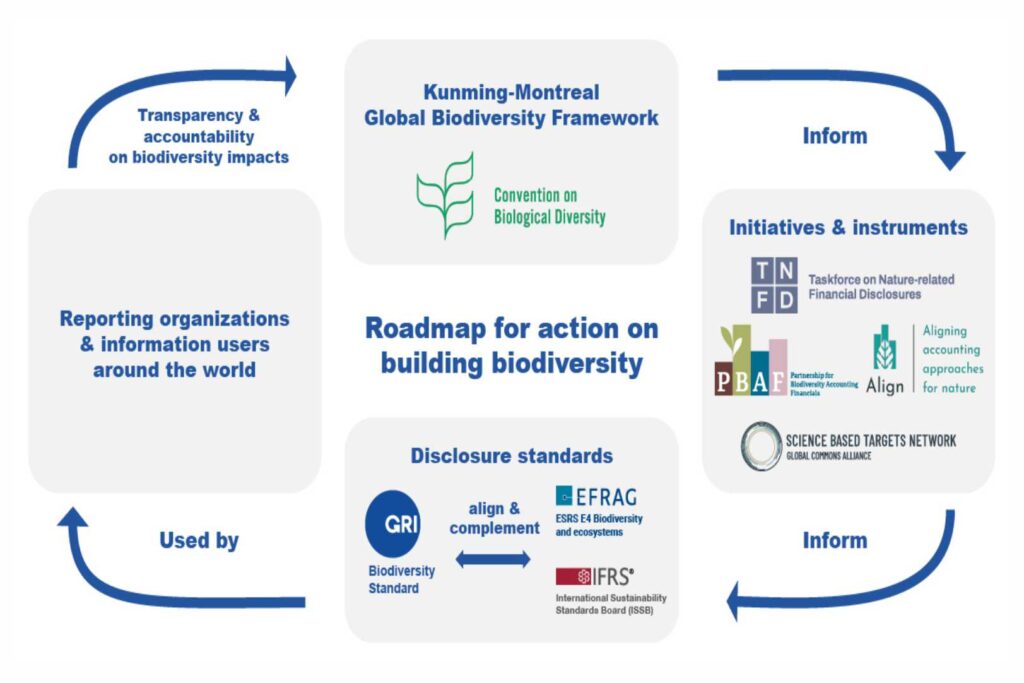
Biodiversity reporting has become a critical focus for businesses, especially in light of new international regulations. The Global Data and Biodiversity Framework (GDF), established at COP 15, emphasises the importance of understanding various regulations, such as the EU’s Deforestation Regulation, which directly impacts supply chains. Companies involved in exports must prepare for due diligence regarding their biodiversity impacts, ensuring compliance with these emerging standards.
Many organisations face significant challenges in data collection and reporting, which are essential for demonstrating their sustainability efforts. To address these challenges, tools like the European Sustainability Reporting Standards (ESRS) and the Corporate Sustainability Due Diligence Directive (CSDDD) are recommended to enhance reporting practices and ensure transparency in operations.
Implementing Initiatives
Financial implications are also paramount, as businesses will need to account for their ecological impacts in financial statements. The upcoming International Financial Reporting Standards (IFRS) will require companies to quantify their biodiversity dependencies and impacts, making proactive environmental management crucial. Current actions taken by businesses will shape future reports, highlighting the importance of long-term planning.
Successful examples of companies implementing biodiversity initiatives illustrate that collaboration across sectors is vital for effective biodiversity management. Addressing biodiversity is not just a regulatory requirement; it also presents an opportunity for businesses to showcase their commitment to sustainability.
Impacts and Dependencies
Key frameworks like the Taskforce on Nature-related Financial Disclosures (TNFD) can help businesses identify and assess nature-related risks and opportunities. TNFD’s integrated approach for the identification and assessment of nature-related issues called the LEAP approach is designed for use by organisations of all sizes and across all sectors and geographies. By employing a LEAP framework, companies can better understand their impacts and dependencies on biodiversity.
Globally, businesses are urged to adopt comprehensive reporting practices and engage in collaborative efforts to enhance resilience while contributing positively to environmental conservation. By understanding their value chains and interactions with nature, companies can effectively manage risks associated with biodiversity loss while seizing opportunities for sustainable growth.
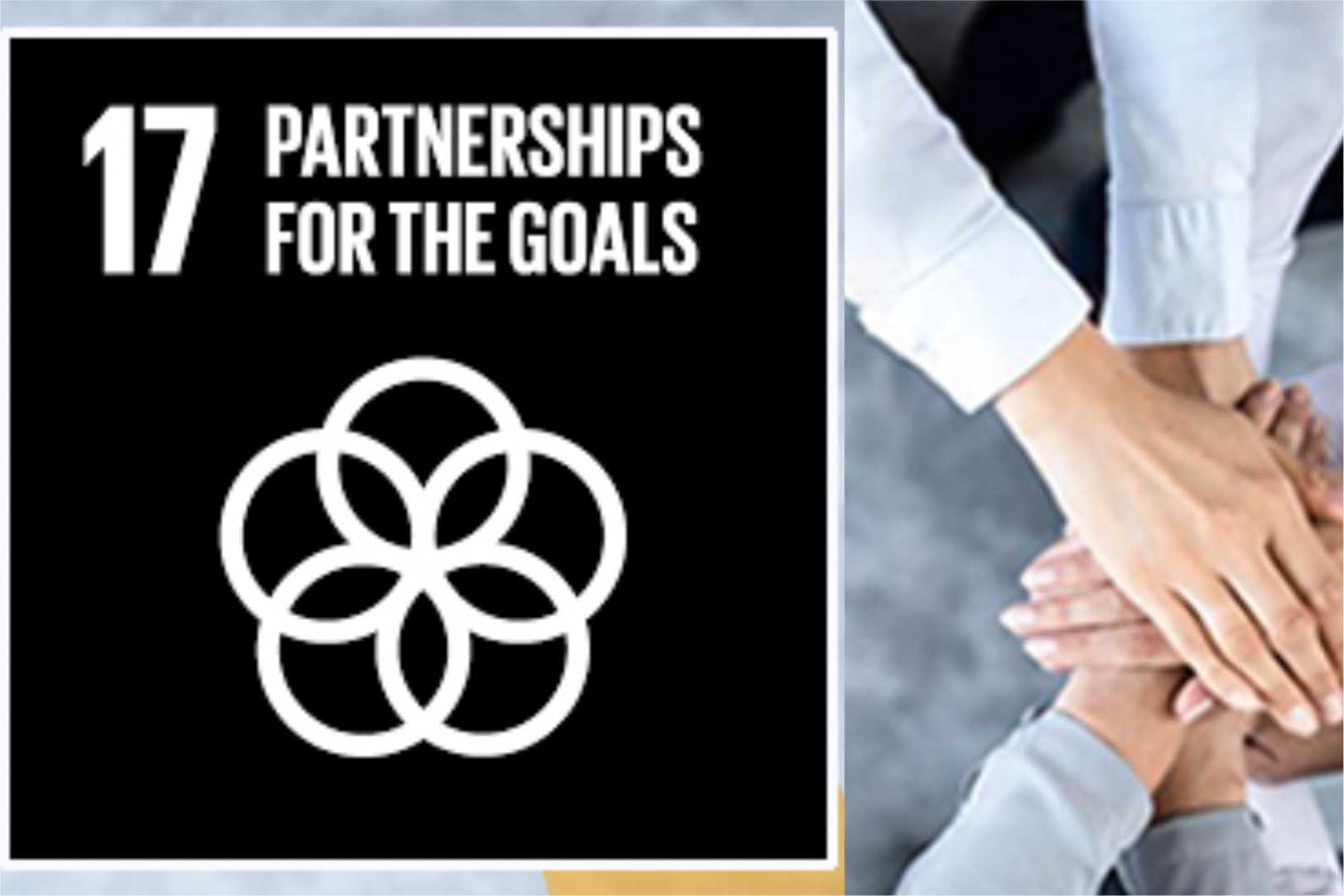
Private Sector Driving National Initiatives

Sri Lanka is making significant efforts to protect its biodiversity and align with global environmental initiatives. One of the key steps the country has taken is the formation of the National Biosecurity Team to implement the goals set by the Convention on Biological Diversity (CBD), which Sri Lanka ratified in 1994. These efforts aim to develop sustainable practices across various sectors, with a focus on fostering harmony between people and nature by 2050. However, the government alone cannot achieve these ambitious goals. The involvement of the private sector is crucial for making meaningful progress.
The National Biodiversity Strategic and Action Plan (NBSAP) outlines 20 strategic targets aimed at conserving biodiversity and promoting sustainable development. These targets address a wide range of areas, from raising public awareness and integrating biodiversity into national economic policies, to protecting ecosystems and promoting sustainable resource management. Some targets specifically call on the private sector to engage in biodiversity conservation, disclosing their environmental impacts and adopting sustainable practices.
New Approaches to Landscape Management
Despite having strong frameworks in place, the government faces challenges in implementing many of these targets. For example, there are six comprehensive plans for nature-based tourism developed by the World Bank’s Ecosystem Conservation and Management Project (ESCAMP), but they remain inactive due to funding challenges. These plans, if activated, could bring in local and international visitors, boosting the economy and fostering sustainable tourism. The private sector’s involvement in such initiatives could unlock tremendous potential and help bring these dormant projects to life.
Another area where private sector involvement is critical is in landscape management. There are two well-developed plans for biodiversity-rich areas prepared by ESCAMP. One such plan is the Sinharaja Forest Range Landscape Management Plan. The other such comprehensive plan is the Hurulu-Kaudulla-Kanthale Landscape Management Plan. Businesses have an excellent opportunity to invest in sustainable practices within these landscapes, benefiting from their natural beauty and contributing to long-term conservation efforts. By working together with the government and other stakeholders, the private sector can help realize the full potential of these regions and play a key role in preserving Sri Lanka’s natural heritage.
Funding Biodiversity Management
The biggest obstacle to implementing many of these sustainable initiatives is the lack of financial resources. Here, the private sector can step in by co-financing projects that need funding to get started. Whether through direct investments, partnerships, or other funding arrangements, businesses can help support sustainable tourism, conservation, and biodiversity management projects.
The government is eager to collaborate with the private sector and is open to showcasing potential projects where partnerships can lead to meaningful progress. Through these collaborations, both the private sector and the government can achieve greater success in driving sustainable initiatives that benefit the environment and the economy.
Unlocking Potential through Collaboration
The active participation of the private sector is essential to achieving Sri Lanka’s biodiversity and sustainability goals. By fostering collaborative partnerships with the government and other stakeholders, businesses can help overcome financial and operational challenges while making a significant positive impact on both the economy and the environment.
Together, we can leverage resources, share knowledge, and drive innovative solutions to create a sustainable future that not only benefits nature but also enhances economic growth and community resilience. Engaging in these partnerships will not only pave the way for sustainable development but also position the private sector as a leader in environmental stewardship. Biodiversity Sri Lanka is committed to make this a reality.
Derived from the discussions that took place on this subject at the 2024 Annual Technical Sessions of Biodiversity Sri Lanka.

Reporting on Nature and Biodiversity
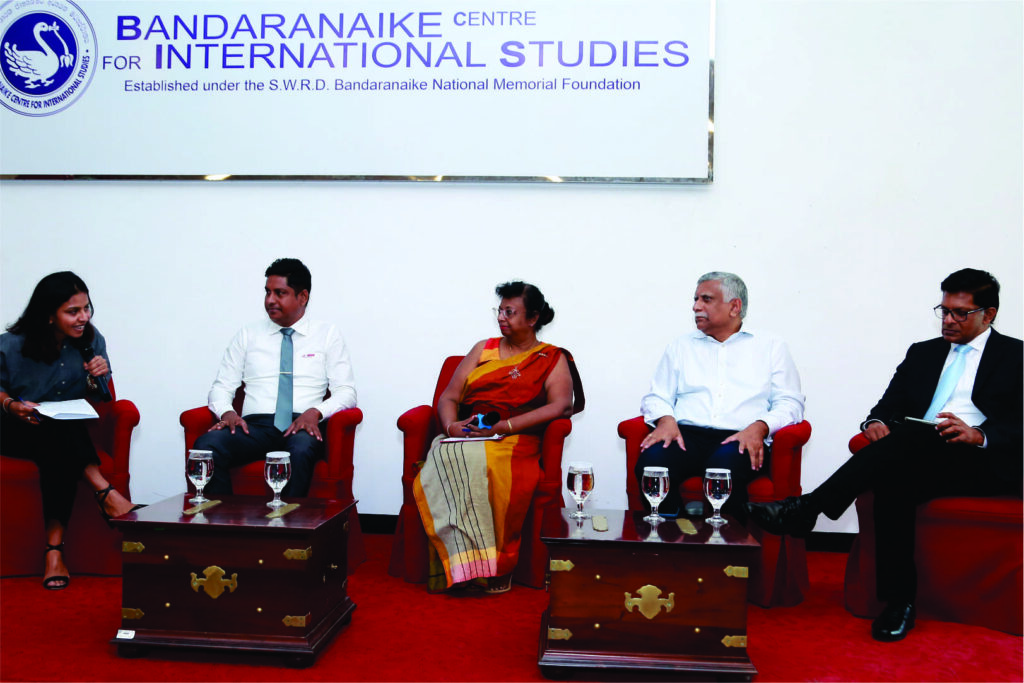
The First Segment of Biodiversity Sri Lanka’s 9th Annual Technical Sessions held in early September 2024 was titled: “Corporate Reporting on Nature and Biodiversity: What’s Next?”, focused on the growing importance of integrating biodiversity considerations into corporate sustainability reporting. With biodiversity loss accelerating, businesses are increasingly expected to report their impacts and dependencies on nature, alongside their traditional environmental and financial disclosures.
Session Overview
The session emphasised the shift toward more comprehensive corporate reporting, where nature and biodiversity are viewed as critical components of sustainability. Many companies are now facing pressure from investors, regulators, and stakeholders to disclose how their operations affect ecosystems and what steps they are taking to mitigate these impacts. The panel discussion delved into the evolving frameworks that businesses can adopt to incorporate biodiversity into their Environmental, Social, and Governance (ESG) reports, while also exploring the challenges and opportunities in this field.
Resource Persons
The session featured distinguished experts, with Ms. Pyumi Sumanasekera delivering the Keynote Address. The interesting panel discussion was moderated by Head of Sustainability/Senior Assistant Vice President of John Keells Holdings Ms Anosha Koralage. The panelists from both the private sector and environmental organisations included Executive Director of UN Global Compact Mr Rathika de Silva, Executive Director/Chief Financial Officer of DIMO Mr Suresh Gooneratne, and Senior Manager – Sustainability & CSR of INSEE Cement Mr Suresh Lakmal, Consultant – Ministry of Environment Dr Jinie Dela. The panelists discussed global trends in nature-related financial disclosures, the tools available to businesses for assessing their impacts on biodiversity, and the steps Sri Lankan companies can take to lead in this growing area of corporate accountability.
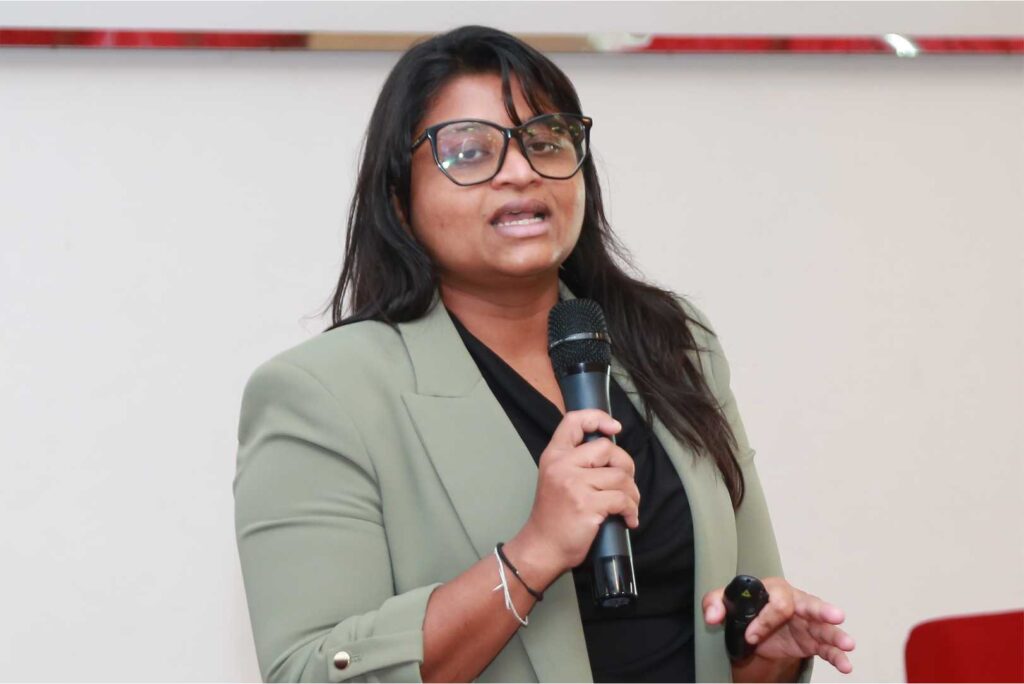
Reporting on Nature and Biodiversity
Ms. Pyumi Sumanasekera’s presentation outlined the critical need for Sri Lankan companies to report on their biodiversity impact. With many global industries—especially those reliant on natural resources—facing biodiversity risks, reporting on nature is becoming essential for businesses. The presentation emphasized that corporate sustainability reporting frameworks are evolving to include biodiversity metrics, allowing companies to better understand their dependencies on ecosystems and the impact of their operations on natural capital.
Nature-related risks can disrupt business operations and supply chains, particularly in industries such as agriculture, fisheries, and tourism, which are vital to Sri Lanka’s economy. The integration of biodiversity into corporate reports can help companies assess and manage these risks while contributing to global and national conservation efforts. Inaction on biodiversity could lead to reputational damage, financial risks, and increased regulatory pressures.
Panel Discussion Highlights
The panel discussed practical ways to incorporate nature-related disclosures into existing reporting frameworks and highlighted the importance of partnerships between businesses, government agencies, and conservation groups. This collaboration is key to driving action on biodiversity protection while maintaining economic resilience.
- The need for companies to integrate nature into their climate transition strategies.
- How frameworks like the Global Reporting Initiative (GRI) and Task Force on Climate-related Financial Disclosures (TCFD) are being adapted for biodiversity.
- The role of businesses in addressing biodiversity loss as part of a holistic approach to sustainability.
By adopting best practices in biodiversity reporting, Sri Lankan businesses can not only contribute to environmental sustainability but also strengthen their position in the global market as responsible and forward-thinking companies.
Call to Action
Session 1 concluded with a call to action for Sri Lankan businesses to embrace biodiversity reporting. The discussion underscored the necessity for companies to not only address climate change but also biodiversity loss, which is deeply interconnected with their long-term sustainability. Through better reporting practices and collaboration, businesses can protect Sri Lanka’s natural resources and contribute to a healthier, more sustainable future.

Step Up for Nature: Why Sri Lanka’s Private Sector Must Join Forces for Biodiversity!
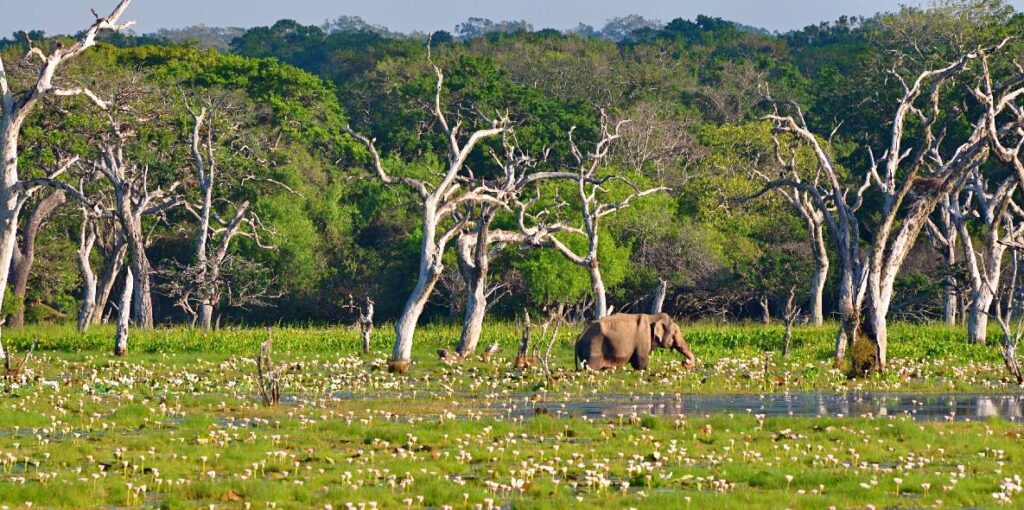
As the world faces accelerating climate change, dwindling resources, and increasing social expectations, traditional business models are quickly becoming obsolete. Sustainability is no longer just an ethical choice—it’s essential for long-term success and resilience of the business environment. Today’s forward-thinking businesses understand that responsible resource management isn’t just about survival; it’s about thriving in a future where environmental and social risks will shape the market. While many global companies have made strides by setting sustainability goals and improving supply chains, the urgency of the climate crisis shows that progress must be faster and more impactful. Now, sustainability isn’t just a trend—it’s the new standard for global competitiveness and innovation.
With Sri Lanka’s natural resources under increasing pressure, businesses have a huge role to play in preserving the island’s stunning biodiversity. While traditionally seen as the responsibility of governments and NGOs, protecting our environment is no longer a side issue for companies—it’s becoming essential for the long-term success of local enterprises. Established
Established in 2012 by the Ceylon Chamber of Commerce as the Sri Lanka Business and Biodiversity Platform, and then incorporated as Biodiversity Sri Lanka, BSL is a unique private-sector-driven network that provides the perfect opportunity for Sri Lankan companies to step up, make a difference, and be recognised as sustainability leaders.

Biodiversity in Sri Lanka
Sri Lanka ranks among the world’s top biodiversity hotspots, boasting over 3,000 species of flowering plants, 250 species of birds, and nearly 125 species of mammals. However, more than 33% of its plant species and half of its amphibians are endemic, meaning they exist nowhere else on earth. Alarming trends show that deforestation, climate change, and human activity are placing this precious biodiversity at risk. The private sector in Sri Lanka, as a major economic driver, holds the key to reversing these trends.
Despite efforts from the government and non-profits, Sri Lanka loses around 8,000 hectares of forests each year according to estimates published by the UN-REDD Programme in 2017. While one in every four species is considered threatened in Sri Lanka, private sector companies, large and small, can change this by actively participating in conservation efforts and adopting sustainable practices.
Boosting your CSR Impact
Consumers and investors are now evaluating companies not just on profits but on their contribution to social and environmental good. According to a recent Deloitte survey, 58% of consumers now actively seek companies that align with their values, including sustainability. Biodiversity Sri Lanka offers a platform where businesses can channel their Corporate Social Responsibility (CSR) efforts into impactful biodiversity projects, such as the ongoing Life to Our Forests initiative in Kanneliya, which focuses on restoring Sri Lanka’s forests, one of the most biodiverse areas in the country.
Joining Biodiversity Sri Lanka lets your company align with crucial conservation goals while enhancing your CSR footprint. Whether it’s sponsoring tree planting initiatives, protecting mangroves, or financing wildlife conservation, you’ll be directly involved in projects that make a difference.
Enhancing ESG Credentials
The Environmental, Social, and Governance (ESG) criteria are increasingly influencing investment decisions. Studies show that companies with strong ESG practices tend to outperform their peers financially. In fact, firms with higher ESG ratings have 28% higher returns compared to those lagging behind, according to a report by McKinsey & Company. Biodiversity Sri Lanka can help Sri Lankan companies strengthen their ESG credentials by providing a structured approach to biodiversity conservation, complete with measurable impacts and international visibility.
For instance, by participating in Biodiversity Sri Lanka-led initiatives like wetland conservation or agroforestry projects, businesses can showcase tangible contributions to biodiversity in their sustainability reports, appealing to both investors and eco-conscious consumers.
A Global Network of Expertise
Biodiversity Sri Lanka is not just a local initiative—it’s connected to global giants like the International Union for Conservation of Nature (IUCN), the World Business Council for Sustainable Development (WBCSD), and the Global Partnership for Business and Biodiversity (GPBB). These partnerships bring international expertise, funding opportunities, and innovative ideas to Sri Lanka’s biodiversity conservation landscape while focusing on scientific approaches.
When your company joins Biodiversity Sri Lanka, you tap into this wealth of knowledge and collaboration, gaining access to resources and strategies that align with global best practices. Whether it’s sustainable agriculture, waste management, or climate change adaptation, Biodiversity Sri Lanka provides the tools, expertise, and networks to help businesses succeed in sustainability efforts.
Working to Achieve Global Goals
Sri Lanka is a signatory to the Convention on Biological Diversity (CBD) and has committed to achieving the UN Sustainable Development Goals (SDGs). Private sector engagement is critical for achieving these ambitious biodiversity targets, particularly in protecting ecosystems, restoring habitats, and halting species loss. Biodiversity Sri Lanka actively aligns its work with these international frameworks, giving companies an easy entry point to contribute to global biodiversity and sustainability goals.
By joining Biodiversity Sri Lanka, your company will be part of a movement that is driving positive change locally while contributing to global initiatives like the Paris Agreement on Climate Change and the Aichi Biodiversity Targets.
How You Can Join Hands with BSL
Biodiversity Sri Lanka offers flexible opportunities for private sector engagement, recognising that every business has unique capabilities and interests. Here are a few ways for your business to contribute:
Many Biodiversity Sri Lanka members have been involved in supporting on-the-ground conservation work such as reforesting degraded lands, restoring mangrove ecosystems, and protecting wildlife corridors. For example, Biodiversity Sri Lanka’s mangrove restoration project is helping safeguard coastal ecosystems from erosion and climate change impacts.
While understanding the broad benefits of reversing the trend in environmental degradation, most companies are reluctant to begin intervening in natural ecosystem restoration as this requires specialised knowledge and long-term time involvement. BSL has recognised the fact that such businesses need technical support as well as assistance in liasing with government stakeholders. Using many years of experience in facilitating field-based interventions and leveraging on its strong relationship with the public sector in Sri Lanka, BSL has now packaged its field activities to offer the LIFE Series of projects to the private sector. The LIFE Series currently comprises of five pathways for corporate involvement in nature-positive environmental interventions at a national level:
- Life to Our Forests (LOF) – Restoration of a degraded fern land in the Kanneliya Forest Reserve in collaboration with the Forest Department and IUCN with the objective of creating a legacy of conservation for generations to come by preserving the biodiversity of Sri Lanka’s rainforests.
- Life to Our Mangroves (LOM) – Restoration of mangrove ecosystems to showcase private sector engagement in achieving national biodiversity conservation and climate action goals. This project promotes Accelerated Natural Regeneration of Mangroves (ANRM) to increase carbon sequestration and boost ecosystem services of degraded mangrove ecosystems in collaboration with Wayamba University and the Department of Wildlife Conservation.
- Life to Our Coral Reefs (LOCR) – This is an initiative of Biodiversity Sri Lanka to showcase private sector commitment to conserve Sri Lanka’s blue resources. In collaboration with the Department of Wildlife Conservation, IUCN and the Blue Resources Trust, the project empowers local communities to adopt sustainable practices that safeguard vital ocean resources.
- Life to Our Beaches (LOB) – By empowering local communities – particularly women – to take care of their beaches as a viable livelihood option, this project provides a pathway for the private sector to protect Sri Lanka’s shores with the support of the Marine Environment Protection Authority (MEPA).
- Life to Our National Parks (LONP) – This is a collaborative initiative of Biodiversity Sri Lanka to showcase private sector engagement in enriching wildlife habitats. The project engages surrounding communities in the removal of Invasive Alien Plant Species (IAPS) in national parks by supporting livelihoods that restore wildlife habitats. This is a collective effort of BSL and the Federation of Environmental Organisations (FEO) together with the Department of Wildlife Conservation.
Biodiversity Sri Lanka encourages businesses to work closely with government agencies and NGOs through the LIFE Series of projects that focus on providing economic benefits to local communities while safeguarding natural ecosystems. This could include supporting rural livelihoods through sustainable farming initiatives, promoting eco-tourism, or funding biodiversity research.
With science and technology constantly evolving to monitor, report, and streamline environmental interventions, Biodiversity Sri Lanka provides capacity-building opportunities for businesses to learn how they can integrate biodiversity conservation into their operational practices. This is organized through the BSL Academy which organises workshops on sustainable agriculture, eco-friendly business models, biodiversity management, sustainability reporting, and so on.
Companies that join Biodiversity Sri Lanka can use their voice to advocate for better environmental policies, aligning with national efforts to strengthen Sri Lanka’s biodiversity laws and protection measures. As a well-respected entity by the Government, BSL has been advocating for more stringent policies to protect and conserve Sri Lanka’s natural resources.
Is Your Organisation Eligible?
Biodiversity Sri Lanka’s membership is open to any company that recognises the need for environmental sustainability and wants to be part of the solution in a pragmatic manner. The platform already includes some of the country’s leading corporates across industries like agriculture, tourism, manufacturing, and finance. Becoming a member of Biodiversity Sri Lanka will provide the ideal platform for driving environmental impact and aligning with both local and global sustainability trends if your business:
- Relies on natural resources (e.g., agriculture, fisheries, forestry)
- Operates in sectors affected by environmental change (e.g., real estate, tourism)
- Has a large environmental footprint (e.g., manufacturing, transportation)
- Sees the potential for nature-based investments (e.g., banking, renewable energy, recycling)
- Seeks to improve its ESG ratings or CSR impact
It is Now Time to Act Together
In 2023, a UN report warned that without urgent action, one million species globally are at risk of extinction due to human activities, including habitat destruction and pollution. Sri Lanka is at a tipping point. Our forests are shrinking, coastal ecosystems are deteriorating, and climate change is intensifying the threats to biodiversity. We’ve already seen alarming declines in species like the Sri Lankan leopard and the purple-faced langur. But there is hope. By committing to biodiversity conservation through platforms like Biodiversity Sri Lanka, your company can be part of the solution. Don’t wait until it’s too late. The time for businesses to act is now. If you are a company operating in Sri Lanka looking to make a lasting difference while also improving your bottom line, joining Biodiversity Sri Lanka is the way forward. Join Biodiversity Sri Lanka today and help protect the natural world that sustains us all. Together, we can ensure that future generations inherit a country as rich in biodiversity as the one we’ve been fortunate enough to enjoy.
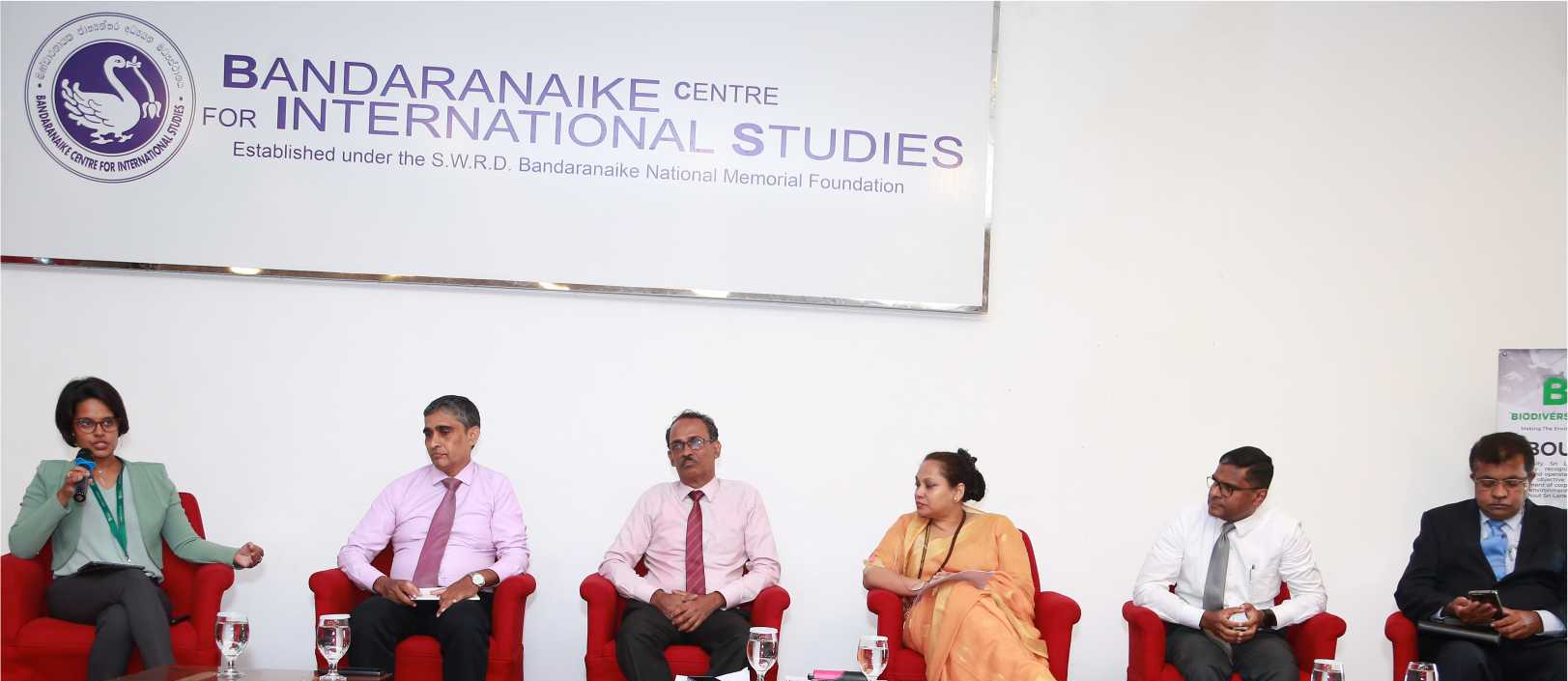
Climate Risks and Green Finance

The second segment of Biodiversity Sri Lanka’s Annual Technical Sessions, titled “Climate Risks & Green Finance: Exploring the Intersection”, brought to light the growing convergence between climate change impacts and the financial sector. As climate risks escalate, businesses, particularly in Sri Lanka, must assess how these risks affect their operations, while also exploring green finance as a tool to support climate resilience and sustainable development.
Session Overview
This session focused on the growing intersection of climate risks and green finance, and the need for Sri Lankan businesses to integrate climate resilience into their strategies. Green finance was highlighted as a key tool for funding sustainable projects, enabling companies to reduce their carbon footprint. The private sector, especially banks, was recognised for its crucial role in driving the low-carbon transition through strategic investments.
Resource Persons
The session featured distinguished experts, with Mr Ranga Pallewala delivering the Keynote Address. The interesting panel discussion was moderated by General Manager – Group ESG of Hayleys PLC Ms Prashani Illangasekera. The panelists from both the private sector and state sector Director General – Sustainable Development Council Ms Chamindry Saparamadu, Director Climate Change of the Ministry of Environment Mr Leel Randeni, Vice President (Sustainability & Consulting) of DFCC Bank PLC/DFCC Consulting (Pvt) Mr Nalin Karunatileka, Chief Executive Officer of the National Cleaner Production Center Mr Samantha Kumarasena, and Industrial Development Officer of the Ministry of Industries Mr Lalith Wasantha. The panelists discussed the nexus between climate risks and green finance, global trends in green financing, and the steps Sri Lankan companies need to take to access green finance.
Key themes from the panel discussion:
The panel discussion following the keynote address brought together experts from both the financial and environmental sectors to discuss practical strategies for managing climate risks and advancing green finance in Sri Lanka. Key points from the discussion included:
- Regulation and Policy Support: Panelists emphasised the growing regulatory push for climate-related financial disclosures. Governments and regulators are increasingly holding businesses accountable for their climate impact, which is expected to lead to better risk management and transparency. Sri Lanka is no exception, with evolving policies encouraging companies to align with global sustainability standards.
- Investment in Green Projects: Sri Lanka is well-positioned to benefit from green finance, particularly in areas like renewable energy, eco-tourism, and climate-resilient agriculture. These sectors not only offer financial returns but also help the country meet its climate goals. The panel highlighted the need for increased investment in these areas to drive sustainable economic growth.
- Long-term Business Resilience: Incorporating climate risks into corporate and financial strategies is vital for building long-term resilience. The panel discussed how companies that fail to account for climate risks may face financial instability, while those that proactively invest in sustainable practices will be better equipped to navigate future challenges.
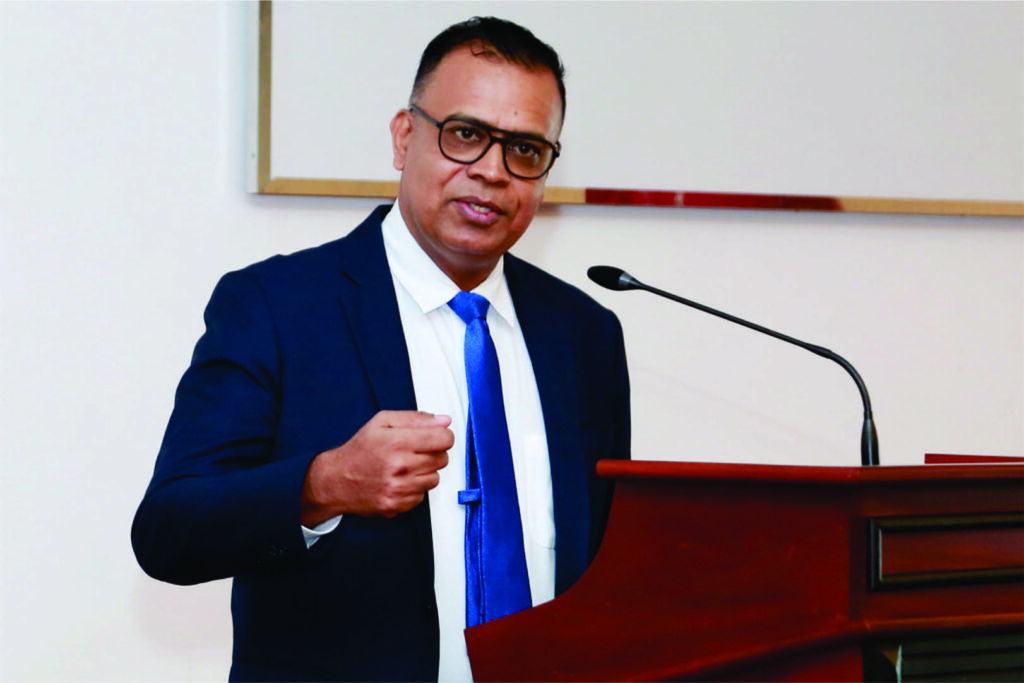
Opportunities to Access Green Finance
In this session, Mr. Ranga Pallewala, a global expert on green finance, delivered a thought-provoking keynote address. He outlined how climate change is not only an environmental challenge but also a significant financial risk, particularly for industries reliant on natural resources. His speech underscored the importance of integrating climate considerations into financial decision-making and highlighted the potential of green finance to fund climate-friendly initiatives. Here are the key takeaways from his address:
Financial institutions and businesses have a crucial role in promoting climate resilience. By financing green initiatives, banks and investors can support sustainable development while protecting their own long-term financial interests. The need for businesses to move away from carbon-intensive industries and toward climate-friendly investments was also highlighted.
Climate risks, including extreme weather events and rising temperatures, are affecting business operations in Sri Lanka. Industries such as agriculture, tourism, and real estate in Sri Lanka are particularly vulnerable. Mr. Pallewala stressed that failing to account for these risks in financial planning could result in severe economic consequences.
Green finance, including tools like green bonds and sustainability-linked loans, offers companies the chance to secure funding for projects that promote environmental sustainability. This includes investments in renewable energy, sustainable agriculture, and projects aimed at reducing carbon emissions. Mr. Pallewala emphasized that green finance is not just a niche market—it is becoming central to the future of sustainable business.
Panel Discussion Highlights
Climate change poses financial risks to key industries in Sri Lanka, such as agriculture, fisheries, and tourism. Companies must integrate climate resilience into their strategies to safeguard against economic disruptions caused by extreme weather and environmental changes.
Green finance offers local businesses the opportunity to invest in sustainable projects like renewable energy, waste management, and eco-friendly agriculture. By leveraging options such as green bonds, Sri Lankan companies can achieve both environmental protection and economic growth.
The private sector in Sri Lanka, particularly banks and financial institutions, has a vital role in promoting a low-carbon economy. By funding green projects, they can lead the transition to sustainable practices while ensuring long-term profitability.
As regulatory frameworks evolve in Sri Lanka, businesses must enhance transparency in disclosing their environmental impact. Adapting to these climate-related regulations will help companies align with national sustainability goals and maintain market competitiveness.
Call to Action
Segment 2 of the Annual Technical Sessions highlighted the urgent need for businesses to incorporate climate risks into their financial planning and leverage the opportunities presented by green finance. With insightful contributions from Mr. Ranga Pallewala and a dynamic panel discussion, the session underscored that addressing climate risks is not only critical for environmental sustainability but also for long-term business resilience. By embracing green finance, Sri Lankan companies can lead the way in building a more sustainable and climate-resilient future.
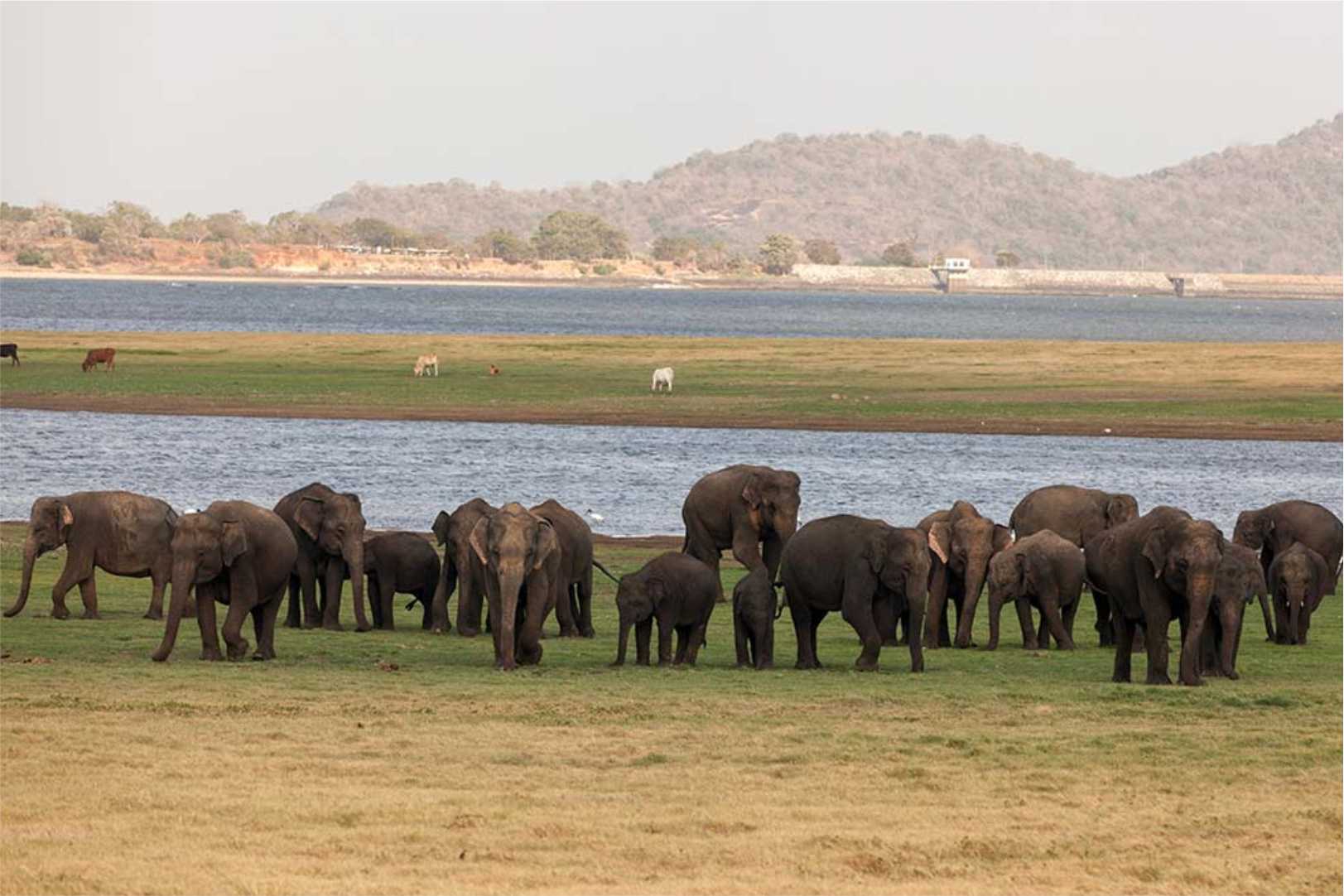
The Return of the Giants
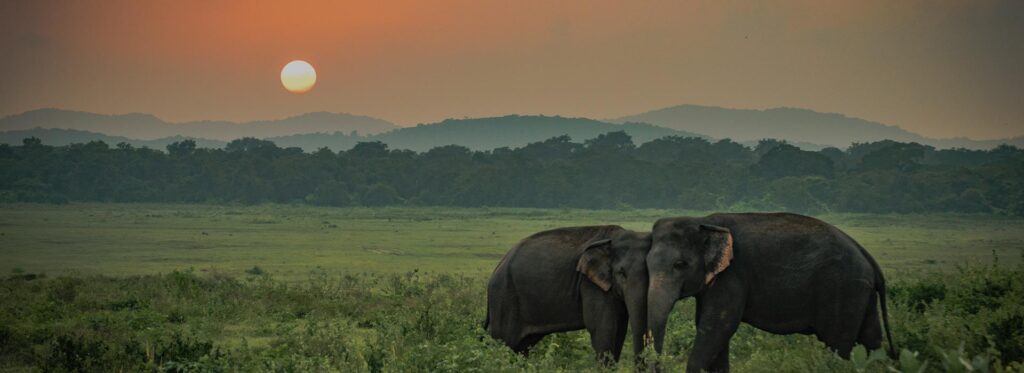
We are delighted to announce that the ‘Elephant Gathering’ in Sri Lanka – a major attraction for wildlife enthusiasts – is now happening again in Minneriya National Park, after a lapse of some years. Popular among both national and international tourists, this annual gathering, usually occurring from July to October, sees smaller elephant herds from surrounding habitats congregate at Minneriya and Kaudulla National Parks. This congregation, fuelled by the diminishing water and food resources in other areas, provides a spectacular sight as the elephants socialise, bathe, drink, feed and potentially find mates. Recognised as the sixth-largest animal gathering globally by Lonely Planet and acclaimed by BBC and CNN Travel, this natural phenomenon offers visitors a unique and memorable experience.
The Minneriya Tank or reservoir is situated in the North Central province. This huge, ancient, man-made reservoir covering 1890 hectares (4670 acres), was constructed by King Mahasen in the 3rd century AD. This reservoir fills up during the North-East monsoon. As the rains cease and the dry season begins, the drought takes its toll, and the water in the reservoir starts to dry up. Although the reservoir shrinks dramatically, it never really runs dry. As the water recedes, it leaves behind fertile, moist soil, where lush grass quickly sprouts. This provides elephants with excellent and much sort-after nutritious food.
The Moragahakanda/Kalu-Ganga irrigation project was originally to supply water through a 24 km pipeline to the Hurulu Oya tank, and then distribute the water from there, to farmers in the North-Central province. Due to delays in completing the pipeline, it was decided a few years ago to divert the water to the Minneriya tank. Though many representations were made to the Government warning of the calamity that would befall the Gathering, the project was commissioned in 2018.
Since then, the discharge of water into the Minneriya tank completely changed the natural rise and fall of water levels – consequently disrupting the gathering of wild elephants. “There is scientific and anecdotal evidence that very young calves were seen to be dying of malnutrition in Minneriya. Many adult elephants were in an emaciated condition due to poor sources of food. The elephant population in the lake field dropped from 389 to 50 over a period of six years,” says Elephant Ethologist and Lead of the National Action Plan for Human-Elephant Conflict Mitigation, Dr Sumith Pilapitiya. He made this observation based on a study carried out on the elephant population in the Minneriya National Park from 2016 to 2021.Dr Pilapitiya noted that in 2016, 389 elephants were recorded from the area; 402 elephants in 2017; 354 in 2018; 223 in 2019; 210 elephants in 2020; while only 20 were recorded in 2021. Further research undertaken by Dr Pilapitiya has shown that there is a definite correlation of the number of elephants and the water levels in the reservoir. He has shown that since the water from the Moragahakande dam was released to the Minneriya reservoir, there was a marked depletion of the number of elephants sighted.
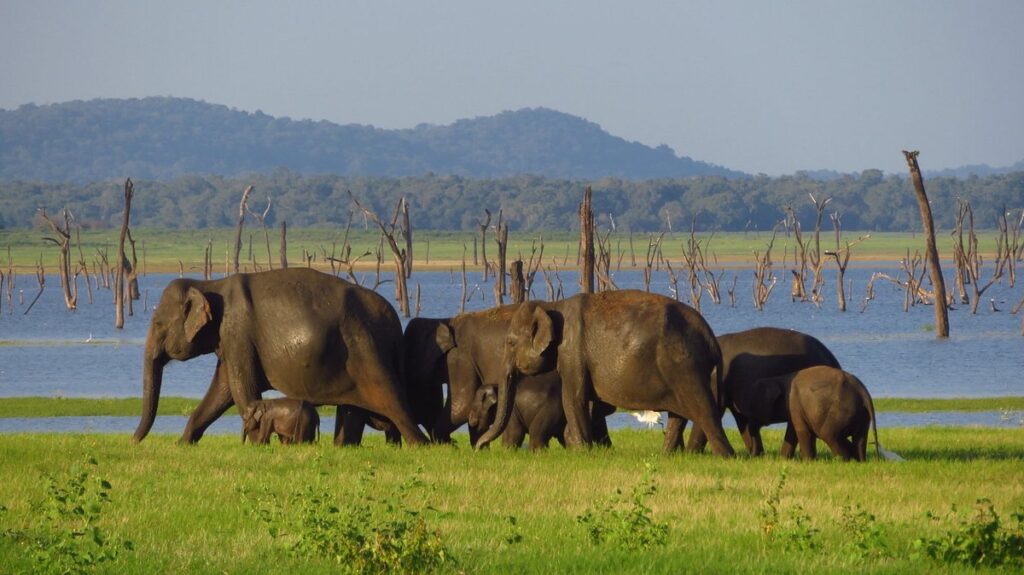
Representations made to the Irrigation Department (ID) met with some understanding. On the one hand the environmentalists wanted the discharge of water into the Minneriya tank stopped, while on the other hand water was needed for irrigation. A dialogue was created between the environmental experts and the Irrigation Department to arrive at a compromise. A compromise was worked out and the water levels managed to some extent, and today we are fortunate enough to see the return of the Giants in MInneriya! Coming soon….listen to Dr Pilapitiya tell us the story first hand…
Animals destroy one-third of Sri Lanka’s crop production: President
Oct 06, 2017 (LBO) – Sri Lanka’s President Maithripala Sirisena highlights that one-third of country’s crop production is affected and destroyed by various wild animals.
Addressing the National Food Production Battle launched on Friday, President said that wild elephants, boar, peacocks, monkeys and apes are among those animals.
There are reports every day about wild elephants invade farmers’ cultivations, destroy crops and damage their homes.
Deforestation has left these animals with less space to live; as a result they have been driven closer to human populations in search of food and can often be seen in cultivated lands.
Farmers see them as a threat to their crops and charge authorities for not taking an action regarding the destruction of their crops.
“This is not a small issue; but no one has a plan and no one speaks about it,” Sirisena stressed.
“There are over 1 million monkeys and apes in Sri Lanka. Monkeys and apes are even found in Colombo 7.”
President emphasized that it is not easy to take a decision with regard to the crop destruction as this is an area deals with various religious, animal welfare and environmental sentiments.
“It’s our duty to protect animals but we may have to take certain decisions because we have to protect people than animals.”
The inauguration of the food programme marked by holding the ‘National Wap Magul Ceremony’ and it is expected to launch many programmes across the country while declaring October 06 to 12 as the National Food Production week.
In the Mahaweli zone, there are an estimated 150,000 of irrigation lands and all those lands are expected to be used for this program.
The extent of irrigable land has been increased to 483,000 ha including 80,000 ha of well drained upland with the commissioning of lands under the Mahaweli river system and other major irrigation schemes.
http://www.lankabusinessonline.com/animals-destroy-one-third-of-sri-lankas-crop-production-president/
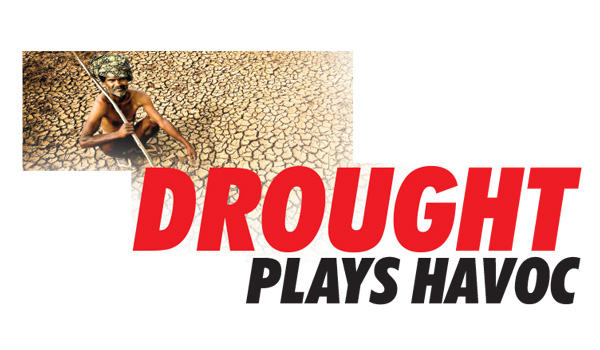
Drought plays havoc
.jpg)
All nine provinces in the country are suffering from a severe drought due to insufficient rainfall. The government requests the residents in these areas to use water with much care and minimize wastage, especially due to the despite the little rainfall received in the past few weeks. The country’s drinking water crisis continues as storage levels of many tanks have dropped drastically. What is worse is that according to the Meteorological Department there will be no rain in these areas until October.
The latest data on electricity generation for 2016 and up to March 2017 released by the Public Utilities Commission of Sri Lanka (PUCSL) shows the sharp impact of the drought on hydro electricity generation. By Q4 2016 and Q1 2017 reservoir levels were at their lowest in five years, and this has had a major impact on the cost of electricity generation as the CEB had to switch to thermal generation. At a higher cost. CEB hydropower generation in Q1 of this year (2017) was the lowest compared to Q1 of the past three years.
Since June/July, 2016 through to March 2017, electricity generation in all hydropower stations was halved (or more) due to the drought. On average every month, the top 6 largest hydropower plants were operating at a fraction of their full capacity.
Irrigation
Irrigation mainly for agriculture purpose has been highly affected by the drought and many agriculture farmers are finding it difficult to maintain their cultivations. Due to low production, vegetable prices have been rising over the time. According to Wasantha Bandara Palugaswewa, Director Irrigation, Water Management, and Training, Department of Irrigation, out of major tanks 73 have got only 15 per cent of overall capacity.
“We have completely cut down the water supply to paddy fields in drought affected areas at the moment,” Palugaswewa said. “We carefully manage water with the help of Sri Lanka Police and I hope we can save the crops,” he added.
Cultivations and farms
The prevailing dry weather conditions are severely damaging the crop production as well as the livestock industry in the country. The drought that lasted for nearly eight months has turned into a crisis situation for many cultivators as well as the farmers in affected areas.
For most of the farmers, it is the worst condition they have seen in decades. Survival has become their only goal as there is no sign of rain for months. Namal Karunarathne, National Organizer, All Ceylon Peasants’ Federation said, ” 118 District Secretariats have been affected by the drought. Areas like Vilachchiya in the North Central Province, which I have visited personally many cultivators are suffering without water even for their consumption like drinking, washing, and cooking. The situation in Ampara remains the same.
“Sri Lanka has enough rivers but we don’t utilize these rivers in a proper manner,” he added. “Many major rivers have been blocked to generate electricity, but what I suggest is generating electricity has many options but agriculture does not. So we should utilize our river water mainly for agriculture and find out alternatives to generate electricity,” Karunarathne said.
Dairy farmers
Not only cultivators but also dairy farmers have equally been affected, he further stated. Especially in areas like Trincomalee, Seruvila and Vilachchiya cattle do not have enough water to drink and some farmers have started selling their herd for meat since they do not have a way of providing food and water. “Dry weather has eliminated many grazing areas and also the government has restricted cattle from entering forest reserves which I think is not fair,” he said. These innocent dairy farmers and their cattle do not harm the forest. I think the government should call an emergency situation for this drought and seek international assistance and aid to stop people suffering.
However, a senior official from a leading dairy company, one of the country’s leading milk-based product manufacturer said they have not seen any decline in their milk supply. “Some of the small scale private milk collectors have stopped purchasing milk from dairy farmers and I do not know whether that is the reason for our supply to remain the same even in areas like Batticaloa, Anuradhapura and Ampara which are severely affected by the drought,” he added. “I think nowadays most of the dairy farmers do not send their cows to the jungle for grazing, but they provide food and water by themselves. So these cattle are not affected by the drought, he further stated.
Disaster management measures
We see a drastic change in the world’s climate and many forest covers having been cut down for various development purposes which lead to the long lasting droughts as well as the drop in ground water levels. According to the National Disaster Management Centre (NDMC) data, more than one million people are suffering for nearly eight months in all the nine provinces in the country due to the ongoing dry weather. The government has already sanctioned more than Rs 40 million to District Secretaries mainly to address the drinking water issue. More than 6,000 tanks have been allocated in many different locations to provide clean drinking water to the affected communities.
Pradeep Kodippili, Assistant Director, NDMC said still some of the areas are not getting sufficient amount of drinking water. Within the 2-3 months we have provided 200 water bowsers and we have been providing them for some time, he added. The Northern Province is the worst affected and even most of the areas in the Eastern Province have not received rain.
Answering a question on whether there were any funds distributed among the affected residents he said funds had been distributed to farmers for their damaged crops for the eight months of drought. The Ministry of Disaster Management has established Disaster Management Units to coordinate ground level conditions. The drought has affected the whole economic situation in these areas Kodippili added. “I should say that the areas like Kalutara and Moneragala which were also affected by the drought have come out of danger as these areas have started experiencing sufficient rainfalls.
“And we are continuing our funding to provide drinking water to drought affected areas,” he said. We have enough funds allocated. We have provided a 24-hour service to the residents so that they can call us if they are in need of drinking water.
Drought mitigation projects
As a long-term measure the NDMC carries out drought mitigation projects which include rainwater harvesting projects and constructing irrigation wells. “We hope to expand our drought mitigation measures with more funds in the future,” Kodippili said. “The government is working on a project with the Arthur C. Clarke Centre for monitoring droughts and predicting them in the future.” he added.
Kodippili also said, “The people need to save water especially and they should properly utilize rain water. There should be a proper mechanism to protect the existing water bodies without getting contaminated.
The country also needs new policies or revise the existing ones in order to face disasters such as droughts.”
Global climate is changing rapidly resulting in many natural disasters in various parts of the world.
As a country with a proud history of being the number one rice producer in the region Sri Lankans had the best practice of using tanks and other water bodies. Both traditional knowledge and discipline were around the use of water.
Many of these practices have disappeared over time. Traditional crop patterns have not been followed by many farmers while encroachments and dumping of waste have increased rapidly. Rapid development has led to the clearance of many natural forest covers.
As a result, we are dealing with more natural disasters such as floods, droughts, cyclones and even landslides causing many deaths and damage to residents. Drought conditions are getting worse day by day in several provinces, and the extremely hot weather has led to stress in daily life and damage to crops and livestock. Preparedness, awareness and proper management of forests and water bodies can only minimize the effects of these harsh weather conditions and no government can alone work towards them.
source – ceylon today, See more at – http://www.ceylontoday.lk/print20170401CT20170630.php?id=27087

